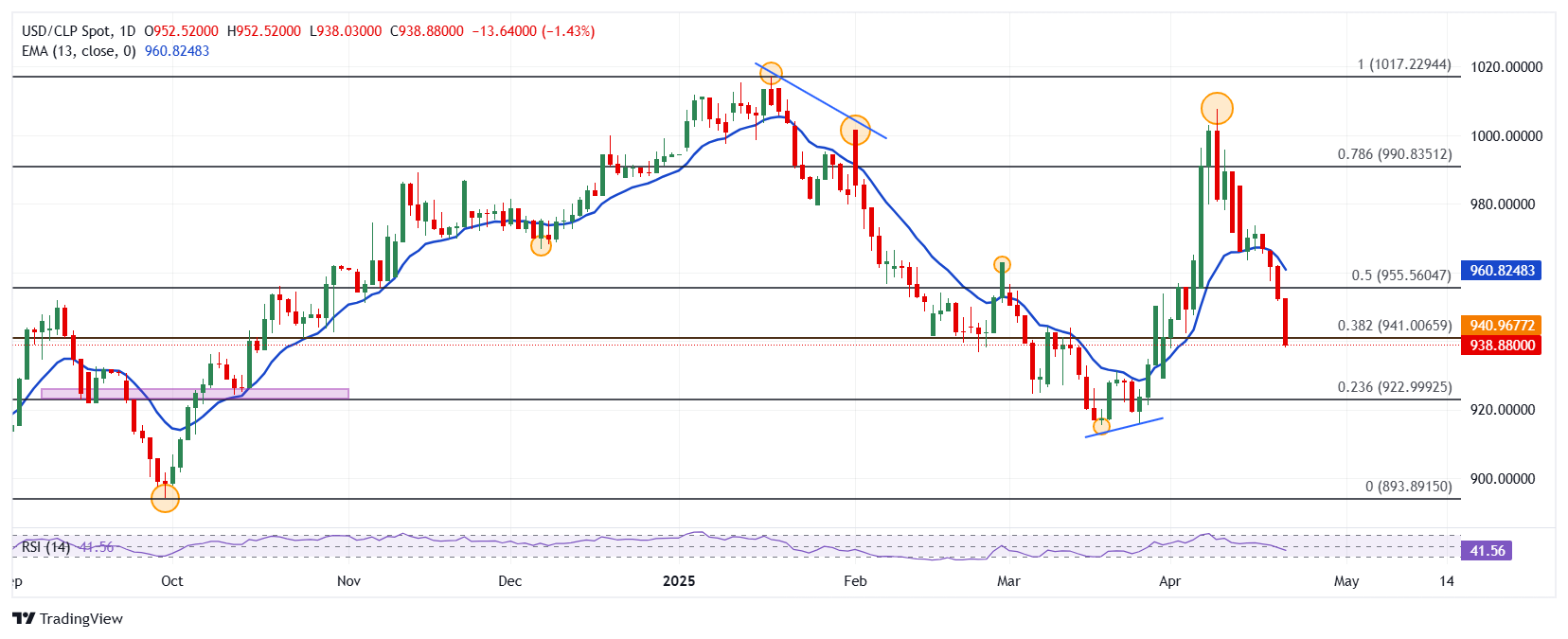- The US dollar slides strongly against the Chilean peso, operating at the moment over 938.32.
- The dollar index (DXY) earns 0.14% in the day, reaching one week at 99.88.
- Copper prices rise 1.29% today, currently quoting at $ 4,8823 per pound.
- Investors will set their attention on the speeches of Alberto Musalem and Christopher Waller, members of the Fed.
- The US economic agenda contemplates the manufacturing PMIS and Global S&P services corresponding to the month of April.
The USD/CLP established a maximum of the day at 952.52, attracting aggressive vendors that dragged the parity to minimums not seen since April 1 in 938.03. At the moment, the USD/CLP falls 1.49% daily, quoting when writing at 938.32.
The Chilean weight is very much prior to the publication of the United States PMIS
The dollar index (DXY) rises 0.14% on Wednesday, reaching a week of one week not seen since April 16 in 99.88, signing its second consecutive day on the rise and consolidating below the psychological level of 100.00.
The president of the United States, Donald Trump, said he has no intention of saying goodbye to Jerome Powell, president of the Federal Reserve, although he recognized his discomfort in the high interest rates.
On the other hand, copper prices maintain a bullish perspective, winning 1.29% daily, currently operating at $ 4,8823 per pound, spinning five consecutive upward sessions.
In this scenario, the Chilean weight extends its profits for the fourth consecutive day, while the USD/CLP loses 1.52% daily, reaching minimums of more than three weeks not seen since April 1 at 938.03.
The US economic agenda contemplates the publication of the manufacturing PMI of the April Global S&P. The consensus of analysts expects to be located at 49.4 points, compared to the 50.2 observed in March. On the other hand, market forecasts expect the PMI of the Global Services S&P to be located at 52.8 points compared to 54.4 registered the previous month.
The attention of the operators will be in the speeches of Alberto Musalem and Christopher Waller, members of the Federal Reserve.
Technical levels in the USD/CLP
The USD/CLP reacted down from a short -term resistance given by the maximum of April 9 in 1,007.73. The next key resistance is observed at 1,017.05, maximum of January 17. To the south, the important support zone is located at 915.57, a pivot point of March 19.
USD/CLP daily graphics

US dollar FAQS
The US dollar (USD) is the official currency of the United States of America, and the “de facto” currency of a significant number of other countries where it is in circulation along with local tickets. According to data from 2022, it is the most negotiated currency in the world, with more than 88% of all global currency change operations, which is equivalent to an average of 6.6 billion dollars in daily transactions. After World War II, the USD took over the pound sterling as a world reserve currency.
The most important individual factor that influences the value of the US dollar is monetary policy, which is determined by the Federal Reserve (FED). The Fed has two mandates: to achieve price stability (control inflation) and promote full employment. Its main tool to achieve these two objectives is to adjust interest rates. When prices rise too quickly and inflation exceeds the 2% objective set by the Fed, it rises the types, which favors the price of the dollar. When inflation falls below 2% or the unemployment rate is too high, the Fed can lower interest rates, which weighs on the dollar.
In extreme situations, the Federal Reserve can also print more dollars and promulgate quantitative flexibility (QE). The QE is the process by which the Fed substantially increases the flow of credit in a stuck financial system. It is an unconventional policy measure that is used when the credit has been exhausted because banks do not lend each other (for fear of the default of the counterparts). It is the last resort when it is unlikely that a simple decrease in interest rates will achieve the necessary result. It was the weapon chosen by the Fed to combat the contraction of the credit that occurred during the great financial crisis of 2008. It is that the Fed prints more dollars and uses them to buy bonds of the US government, mainly of financial institutions. Which usually leads to a weakening of the US dollar.
The quantitative hardening (QT) is the reverse process for which the Federal Reserve stops buying bonds from financial institutions and does not reinvote the capital of the wallet values that overcome in new purchases. It is usually positive for the US dollar.
Source: Fx Street
I am Joshua Winder, a senior-level journalist and editor at World Stock Market. I specialize in covering news related to the stock market and economic trends. With more than 8 years of experience in this field, I have become an expert in financial reporting.







